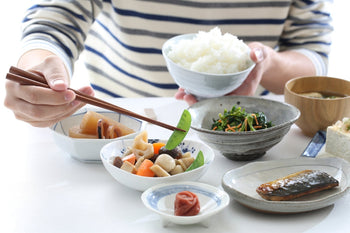

The Fascinating Origin of Rice Balls
Have you ever wondered about the origin of that humble yet delightful Japanese snack, the rice ball? Known as "onigiri" or "omusubi" in Japan, these simple yet exquisite creations have been a staple in the Japanese diet for centuries. The story of rice balls begins in ancient Japan, where they were initially created as a practical solution to preserve rice and make it portable. Warriors used to carry rice balls during battles as a convenient food source that provided energy and sustenance.
Legend has it that rice balls date back to the Heian period, around the 8th century. The first written record of onigiri was found in Lady Murasaki Shikibu's diary, "The Tale of Genji," suggesting that rice balls were already a popular food item during this time. Over the years, rice balls have evolved, with various fillings and flavors being introduced to cater to different tastes. This evolution highlights the adaptability of Japanese cuisine and its ability to merge tradition with innovation.
Today, rice balls are not just a simple meal; they are an integral part of Japanese culture. From convenience stores to high-end eateries, these scrumptious snacks can be found everywhere in Japan. Their enduring popularity is a testament to their timeless appeal and versatility.
The Allure of Onigiri in Japanese Culture
Rice balls hold a special place in the hearts of the Japanese people. But what makes them so popular and beloved? One reason is their simplicity, which allows for endless customization and creativity. Each onigiri is a unique work of art, crafted with care and attention to detail. Japanese people view rice balls as a symbol of comfort and home, often evoking fond memories of family gatherings and picnics.
Another reason for their popularity is their accessibility. Rice balls are a common sight in convenience stores across Japan, making them an easy and affordable snack option for busy city dwellers. They are also a popular choice for bento boxes, offering a balanced and nutritious meal that can be enjoyed on the go. The ease of preparation and portability of rice balls make them an ideal food choice for various occasions.
In addition, rice balls have become a cultural icon, representing the essence of Japanese cuisine. They are often featured in films, anime, and literature, further cementing their status as a beloved Japanese snack. Whether you're a local or a traveler exploring Japan, enjoying a freshly made rice ball is a must-try experience that connects you to the rich culinary heritage of the country.
Crafting the Perfect Rice Ball at Home
Making rice balls at home is a rewarding and enjoyable experience. Not only do you get to experiment with different fillings and flavors, but you also get to enjoy the satisfaction of creating something delicious from scratch. To make the perfect rice ball, you'll need a few essential ingredients and tools.
First, start with freshly cooked short-grain rice. The key to making great rice balls lies in the rice's consistency, which should be sticky enough to hold its shape. Rinse the rice thoroughly before cooking to remove excess starch and ensure a fluffy texture. Once the rice is cooked, allow it to cool slightly before handling.
Next, prepare your fillings. Popular fillings include pickled plum (umeboshi), salted salmon, and tuna with mayonnaise. However, feel free to get creative and try different combinations. Place a small amount of filling in the center of a portion of rice, then gently mold the rice around the filling to form a triangular or cylindrical shape. Use a little salt on your hands to prevent the rice from sticking and to add flavor.
Finally, wrap the rice ball with a sheet of nori (seaweed) for added taste and texture. The nori not only enhances the flavor but also helps keep the rice ball intact. With practice, you'll be able to create beautifully crafted rice balls that rival those found in Japanese restaurants.
Exploring Popular Onigiri Fillings
One of the joys of rice balls is the variety of fillings you can use to create different taste experiences. Traditional fillings are often savory, providing a delightful contrast to the mild flavor of the rice. Some popular fillings include:
- Umeboshi (Pickled Plum) : Known for its tangy and salty flavor, umeboshi is a classic filling that offers a burst of umami with each bite. Its vibrant pink color also adds an appealing visual element to the rice ball.
- Salted Salmon : Grilled or baked salted salmon is a popular choice, offering a rich and satisfying flavor. The combination of tender salmon and fluffy rice is a match made in heaven.
- Tuna Mayo : This modern filling combines canned tuna with mayonnaise for a creamy and savory taste. It's a favorite among children and adults alike, known for its comforting and familiar flavor.
Apart from these traditional fillings, you can also explore creative options such as mentaiko (spicy cod roe), shrimp tempura, or even cheese. The possibilities are endless, allowing you to tailor your rice balls to your personal preferences and dietary needs.
Rice Balls in Japanese Cuisine and Beyond
Rice balls are more than just a popular snack in Japan; they have also gained international recognition and appreciation. The rise of Japanese cuisine globally has introduced rice balls to new audiences, who are eager to explore the diverse flavors and textures they offer. Many Japanese restaurants around the world feature rice balls on their menus, showcasing them as a quintessential part of Japanese dining.
In recent years, rice balls have also inspired creative interpretations and fusion dishes. Chefs and home cooks alike have experimented with incorporating different cuisines and ingredients into rice balls, resulting in innovative variations that push the boundaries of traditional Japanese flavors. From Korean-inspired kimchi rice balls to Italian-style arancini, these modern twists demonstrate the versatility and adaptability of this classic snack.
The Health Benefits of Rice Balls
Rice balls are not only delicious but also offer numerous health benefits. The primary ingredient, rice, is a good source of carbohydrates, providing energy to fuel your daily activities. Additionally, rice is naturally gluten-free, making rice balls a suitable option for those with gluten sensitivities or celiac disease.
The fillings used in rice balls can also contribute to a balanced diet. For example, salted salmon is rich in omega-3 fatty acids, which support heart health and brain function. Umeboshi contains antioxidants and has been traditionally used for its digestive properties. By choosing nutritious fillings, you can enjoy a satisfying snack that supports your overall well-being.
Furthermore, rice balls are portion-controlled, making them an excellent choice for mindful eating. Their compact size encourages moderation, allowing you to savor the flavors without overindulging. Whether enjoyed as a snack or part of a balanced meal, rice balls offer a harmonious blend of taste and nutrition.
Rice Balls and the Art of Presentation
In Japanese cuisine, presentation is an essential aspect that enhances the dining experience. Rice balls are no exception, with their simple yet elegant appearance making them visually appealing. The careful molding of the rice, combined with the vibrant colors of the fillings and nori, creates a visually striking dish that delights the senses.
To elevate the presentation of your rice balls, consider using decorative elements such as sesame seeds, furikake (Japanese seasoning), or even edible flowers. These additional touches not only enhance the visual appeal but also add layers of flavor and texture. Experiment with different shapes and arrangements to create a stunning display that showcases the artistry of your rice balls.
In Japanese culture, the aesthetics of food presentation reflect a deep appreciation for beauty and harmony. By paying attention to the details of your rice balls, you can honor this tradition and elevate your culinary creations to an art form.
Rice Balls and Cultural Significance
Rice balls hold cultural significance beyond their culinary appeal. They are often associated with festivals, celebrations, and family gatherings, serving as a symbol of togetherness and joy. In Japan, it is common to prepare rice balls for events such as Hanami (cherry blossom viewing) or Obon (a festival honoring ancestors).
During these occasions, families and friends gather to share meals and create lasting memories. Rice balls are a popular choice for these gatherings due to their convenience, portability, and ability to cater to diverse tastes. Preparing and enjoying rice balls together fosters a sense of connection and tradition, reinforcing the bonds between loved ones.
For those exploring Japanese culture, rice balls offer a window into the values and practices that shape daily life in Japan. By appreciating the cultural significance of rice balls, you gain a deeper understanding of the role food plays in bringing people together and celebrating shared experiences.
Bringing Rice Balls to Your Culinary Repertoire
If you're inspired to incorporate rice balls into your culinary repertoire, there are countless ways to enjoy and experiment with this versatile snack. Start by mastering the basic techniques of rice ball preparation, and then explore different fillings and flavor combinations to suit your taste preferences.
Consider hosting a rice ball-making party with friends or family, where everyone can contribute their creative ideas and enjoy the fruits of their labor together. This interactive and collaborative experience allows you to share your passion for Japanese cuisine while bonding with loved ones.
Additionally, rice balls make for a convenient and satisfying meal option for picnics, lunches, or snacks on the go. By preparing rice balls in advance, you can enjoy a taste of Japan wherever you are, bringing a touch of culinary magic to your everyday life.
Conclusion
Rice balls, or onigiri, are a delightful and iconic Japanese snack that has captured the hearts of people worldwide. With their rich history, cultural significance, and endless versatility, rice balls offer a unique and flavorful experience that connects you to the essence of Japanese cuisine.
Whether you're a seasoned Japan lover or a curious traveler eager to explore the country's culinary offerings, rice balls are a must-try delicacy that promises to delight your taste buds and enrich your appreciation for Japanese culture. By mastering the art of rice ball-making and experimenting with different fillings and presentations, you can create a culinary masterpiece that celebrates tradition, creativity, and connection.
If you’re ready to venture into the world of rice balls, why not start today? Gather your ingredients, invite your friends or family, and experience the joy of crafting and savoring these delightful snacks together.



